
2021 Ultimate Guide to Cat Anatomy
As the pace of veterinary advancement accelerates, even the most experienced veterinary teams are challenged to keep up with all the changes that impact their practice. Veterinary teams need practical, concise and relevant visual aids at their fingertips while in practice, helping them to prescribe the right information at the right time, to improve client communication, increase compliance rates, enhance the pet owner experience and most importantly better pet health outcomes.
Why visual aids are important
 Your working day is often fast-paced and always changing. But, a large part of your job is pet owner communication.
Your working day is often fast-paced and always changing. But, a large part of your job is pet owner communication.
There are many barriers to managing client communication in a veterinary setting:
- Veterinary support teams find it difficult to juggle work and keep up to date with the latest pet health information
- Consultations are typically restricted to 15-20 minutes
- Pet owners struggle to describe the pet's symptoms
- Pet owners are often pre-occupied with pet restraint or their children
- Veterinarians may not always have the time they need to fully understand a case
- The primary carer is not always present
- There is never enough time to explain everything from diagnosis, treatment plan, prognoses and more
A simple way to overcome these barriers is to use digital visual aids and digital pet treatment summaries.
VetCheck is going to help you be the best vet or nurse clinician you can be by:
- Offering you a proven client communication and engagement system that helps you deliver value and high quality care
- Giving you access to up to date pet health information e.g. health updates, treatment options, potential outcomes and prognoses and tools e.g. anatomical diagrams, clinical formulas and programs and home care videos
- Enhancing the delivery of your healthcare messages, managing client expectations and improving compliance for better pet health outcomes
- Improving your clinical efficiency and streamlining the care you deliver by improving patient data capture and reducing call backs
Needing veterinary visual aids, anatomical diagrams, home compliance videos and images to improve the quality of care that you can provide?
Anatomical terminology
The use of veterinary anatomical terminology can be confusing. When discussing a pet's condition, always use both technical and laymens terminology. People think and hear in pictures. Below are a selection of visual aids to help you communicate the importance of the pet's health as well as the recommended veterinary services.
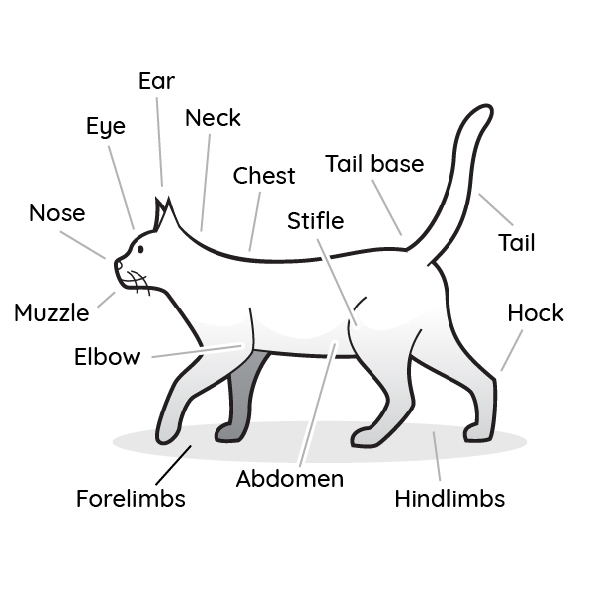
Get access to 100's of anatomical diagrams. Simply register online and once approved, gain access within a few minutes.
JOIN NOW
Common anatomical terminology
Here are some common veterinary terms and their meanings:
| Abdomen | Tummy |
| Dew claw | First digit |
| Patella | Knee cap |
| Stifle | Knee |
| Thorax | Chest |
| Digit | Finger or toe |
| Flank | Side of the body between chest and tail base |
| Muzzle | Nose and upper and lower lip |
| Pinna | Ear flap |
| Tarsus | Hock |
Early kitten development
From birth to 8 weeks, a kitten will go through major growth development phases. They are born with closed eyes and folded ears, meaning they are born blind and deaf. They cannot regulate their own body temperature, nor excrete wastes on their own. After the first week they will start to hear, in the second week their eyes will open and by the third week they will have full sight and hearing. In the forth week they start to run and climb and by 8 weeks they have developed a full set of teeth and can start eating canned and dry kitten food.
| Age | Development |
| Birth | Kitten's eyes are closed and ears folded Born blind and deaf Cannot regulate body temperature Cannot excrete on their own |
| First week | Start to hear |
| Second week | Eyes open - all kittens are born with blue eyes, however, the color may change later Start to see - sight will not fully develop until 8 weeks of age Start to crawl and stand |
| Third week | Full sight and hearing Start to walk Sense of smell increases First teeth may appear Will start to excrete on its own |
| Fourth week | Start to run and climb Learns to play Learns to groom itself |
| Fifth week |
Important socialization skills need to be introduced such as playing with other kittens, interacting with people, being petted for at least 10-15 minutes after feeding Provide a variety of toys particularly to redirect any rough kitten play |
| Eighth week | Develops full set of teeth Fully weaned Eating canned and dry kitten food |
Fostering Kittens Guidelines
Download the VetCheck Fostering Kittens Guideline for more tips on key development stages, feeding, and body temperature.
REQUEST A FREE COPY NOWPet senses
Pets communicate in a very different way than people do. They have the same basic senses like sight, hearing, smell, touch, and taste, but they use them differently to communicate with the world. In general, pets have a much better sense of smell, hearing, and sight than humans. This allows them to identify odours better, to hear noises at greater distances, and to see in the dark. Pets also have sharp teeth and claws that developed to help them survive in the wild.
Cats are solitary (like to be by themselves) creatures and are naturally nocturnal (more active at night). They have excellent vision in the dark and can pick up the slightest of movements, which is perfect for hunting in the wild. They are very flexible creatures that have whiskers to help them jump into and crawl through awkward spaces. Cats have developed sharp claws to help them climb and catch prey in the wild. It is a natural behavior for cats to renew their claws by scratching surfaces.

| Hearing | The shape of the cat’s ears allows it to funnel sound. The ear tubes are lined with fine hairs that pick up sound vibrations. The cat uses these sounds for hunting. Cats can hear frequencies from 30 to 60,000 Hertz (Hz), which means they can hear very high-pitched noises and have much more sensitive hearing than humans. People can hear a range of 20 to 20,000 Hz, and dogs 20 to 100,000 Hz. Cats can also hear sounds from distances four to five times farther than people can. |
| Sight | Cats, with their elliptical pupils, are able to detect movement much better than humans can, making them ideal for hunting. They have developed better sight for early evening and night. Their field of vision is about 200 degrees. They have a shiny membrane, the tapetum lucidum, at the back of their eyes. This allows them to see in low light. In a dark room, this shiny membrane will reflect light from a flashlight. They also have a third eyelid that protects their eyes from injury when out in the dark or hunting. |
| Voice | Cats use their voice to meow, purr, hiss, or growl. Cats usually meow because they want something like food or attention. Loud constant meows often indicate stress or boredom. If your cat meows in this manner early in the morning or after being away from you for hours, it usually means boredom. Try not to react to this bad behavior. Instead, when your cat is behaving in a quiet manner, reward it with positive attention and add more playtimes to the day. Cats usually hiss or growl in threatening situations, as when they see a dog or a stray cat nearby. Do not go near a cat that growls or hisses. |
| Smell | Cats have a very good sense of smell but not as great as some other animals. They have 70 million olfactory cells within their nose that allow them to identify odors in the air from great distances. Cats have scent glands on their forehead in front of the ear canals, along their lips and chin, and under their tail. They use these scent glands to mark objects and people. This is their means of claiming ownership. When your cat rubs its face on you, it is showing you affection as well as marking its scent. |
| Taste | A cat has 30 very sharp, permanent teeth. A cat’s tongue has a rough surface with small barbs to help it tear its food and groom its fur. When a cat licks you, its tongue can feel like sandpaper. Cats have only about 400 taste buds compared to dogs at 1,700 and people at 9,000. Because of this, cats rely on their sense of smell to determine the taste of food. |
| Touch | The skin and hair offer insulation against hot and cold weather. The hair also protects the animal from insects bites, stings, thorns and other sharp objects. They shed their hair depending on the weather e.g. Spring and Fall, and their health e.g. poor diet, fleas, stress. Cats do not rely on sweating to regulate their body temperature. Instead they pant to release excess body heat. |
Get access to more anatomical diagrams on special senses.
- Normal eye
- Nusclear sclerosis
- Cataracts
- Glaucoma
- Corneal ulceration
- Normal ear
- Normal hearing aparatus
- Otitis externa
Simply register online and once approved, gain access within a few minutes.
JOIN NOWCardiovascular and Circulatory System
The cardiovascular system refers to the organs and vessels that allow blood to circulate nutrients, oxygen, carbon dioxide, wastes and hormones to the various cells within the body. The heart pumps oxygenated blood from the lungs to the rest of the body, while pumping deoxygenated blood to the lungs.
The heart is made up of the following structures:
- Aorta
- Pulmonary artery
- Right atrium
- Right ventricle
- Left atrium
- Left ventricle
- Ventricular septum
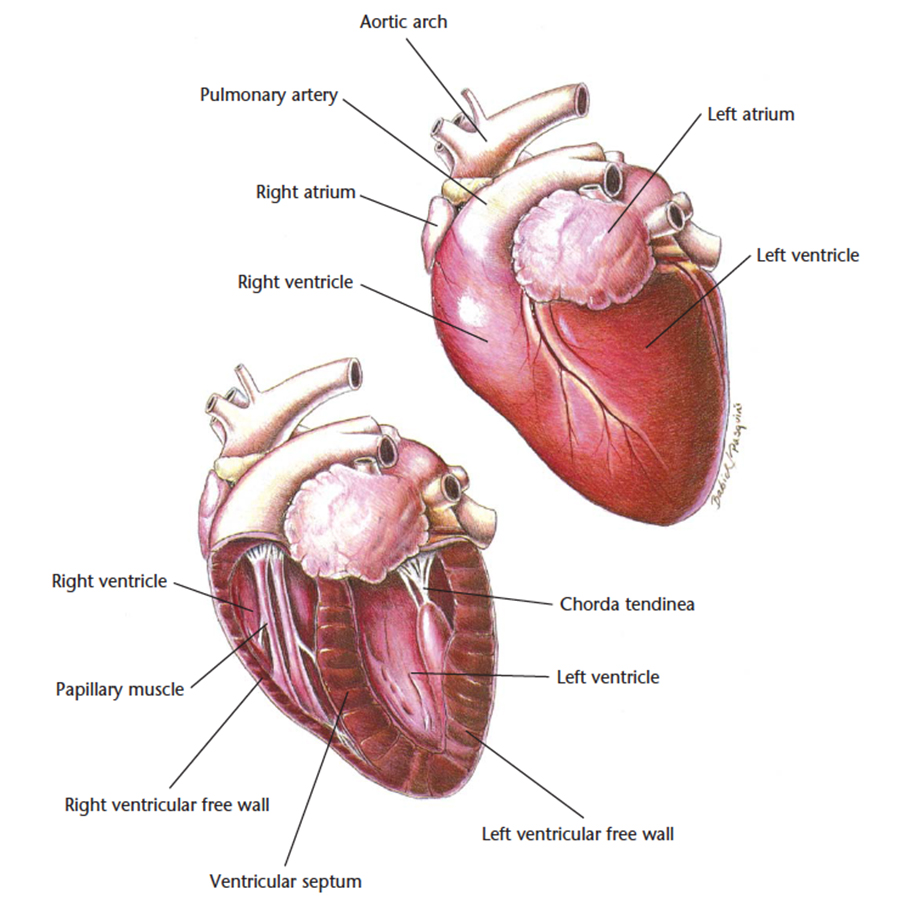
Cardiopulmonary Resuscitation (CPR) Guidelines
Download the VetCheck Cardiopulmonary Resuscitation (CPR) Guidelines for step by step instructions and videos.
REQUEST A FREE COPY NOWBlood vessels
Blood vessels refer to the arteries, veins and capillaries. Arteries carry oxygenated blood away from the heart and vein carry blood back tot he heart. Capillaries are tiny vessels that join the end of an artery to the start of the vein.
Blood
Blood is made up of red blood cells and white blood cells suspended in fluid called plasma. It also contains hormones and other proteins that can help diagnose health conditions in pets. Blood samples can be taken for preanaesthetic bloodwork, diabetic monitoring or senior wellness checks.
Good nutrition
Good heart health starts with good nutrition. Taurine, an important amino acid, is essential for strong heart muscles as well as eye and brain function. Most commercial cat foods contain taurine. But, in the case of homemade diets, cats are at higher risk of taurine deficiency and heart problems.
Cardiovascular conditions are particularly complex. In order for pet owners to make sound health decisions, they need to under the risks and benefits that come with medical treatments and diagnostic tests. Studies have shown that people consider risk information easier to understand and recall when it is presented visually.
Get access to more anatomical diagrams on the cardiovascular system.
- Chronic Valvular Disease
- Heartworm Disease
- Feline Dilated Cardiomyopathy
- Feline Hypertrophic Cardiomyopathy
Simply register online and once approved, gain access within a few minutes.
JOIN NOWDigestive system
The digestive system is made up of the organs responsible for processing food into a format that can be used by the body in the form of energy and nutrients. Food enters the mouth and travels through the oesophagus, stomach, small intestine and large intestine before being passed through the anus as solid waste.
The digestive system includes the:
- Mouth & Teeth
- Tongue
- Salivary glands
- Oesophagus
- Stomach & Stomach Lining
- Small intestine
- Large intestine
- Pancreas
- Liver
- Gall bladder
Nutrition for good health
Cats are obligate carnivores meaning the meat is their main food source. An appropriate diet combines a high quality, balanced, commercial diet and human-grade foods such as pieces of chicken, beef or lamb. Unless you have specific recipes that have been formulated by a veterinary nutritionist, commercial diets should be considered, particularly for kittens up to 12 months of age. All reputable veterinary nutritional companies must follow strict dietary requirements to ensure the diets are balanced and nutritionally beneficial.
Mouth and teeth
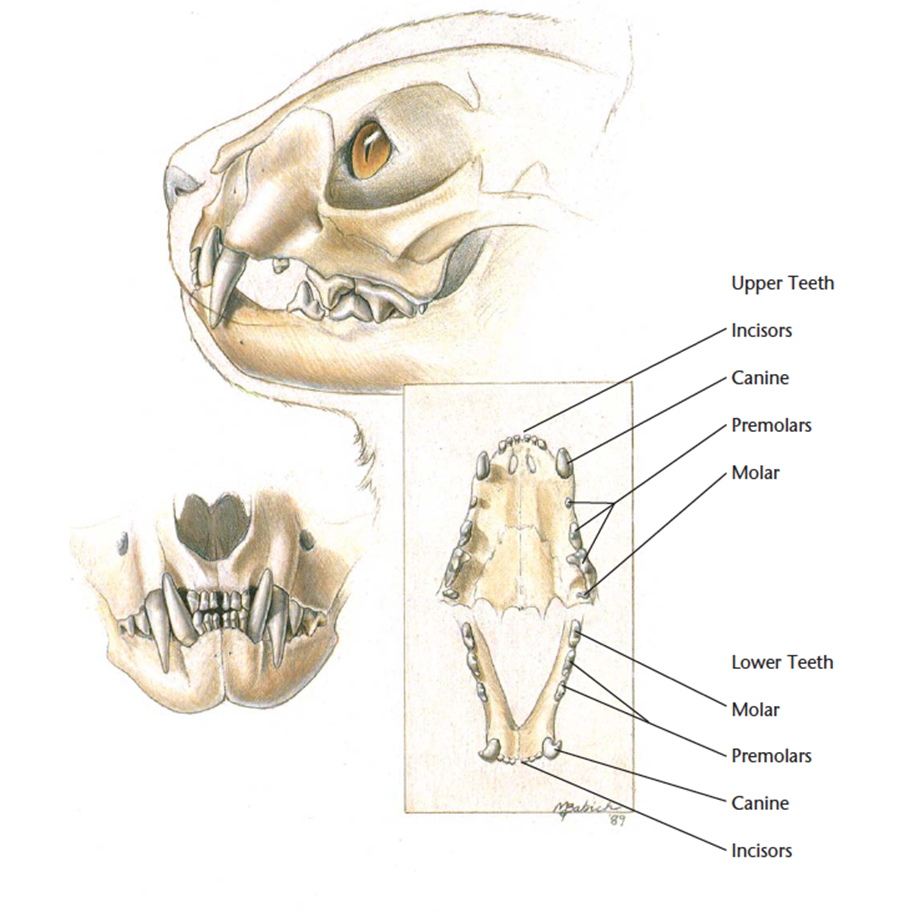
A cat has 30 adult teeth made up of the front incisors, sharp canine teeth, premolars and molars. Their milk teeth fall out between 5-7 months of age.
Stomach and stomach lining
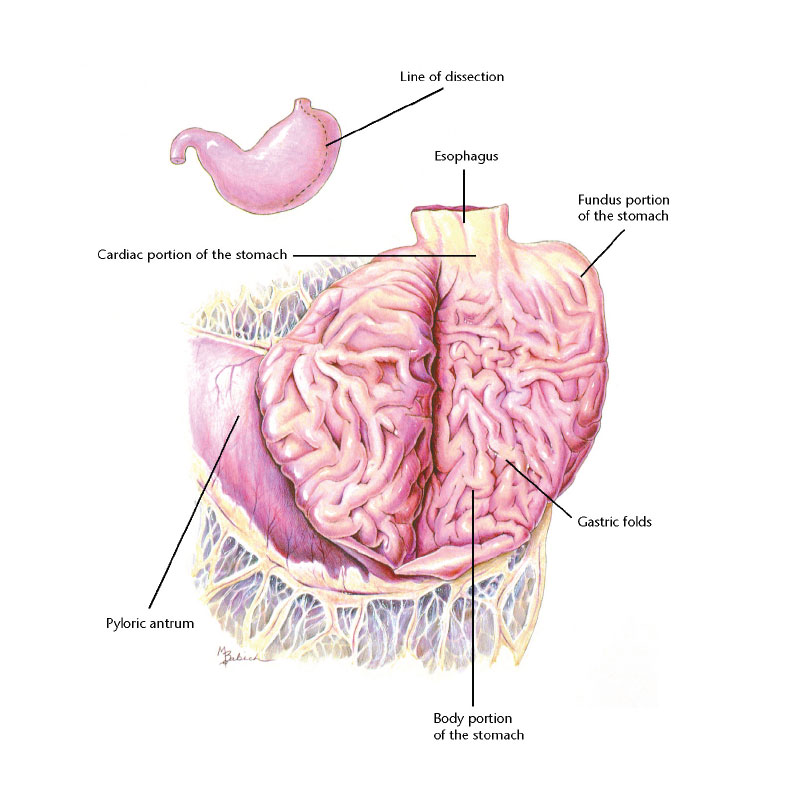
The food enters via the oesophagus, into the stomach is where the food is digested so that the nutrients can be absorbed.
Small intestine
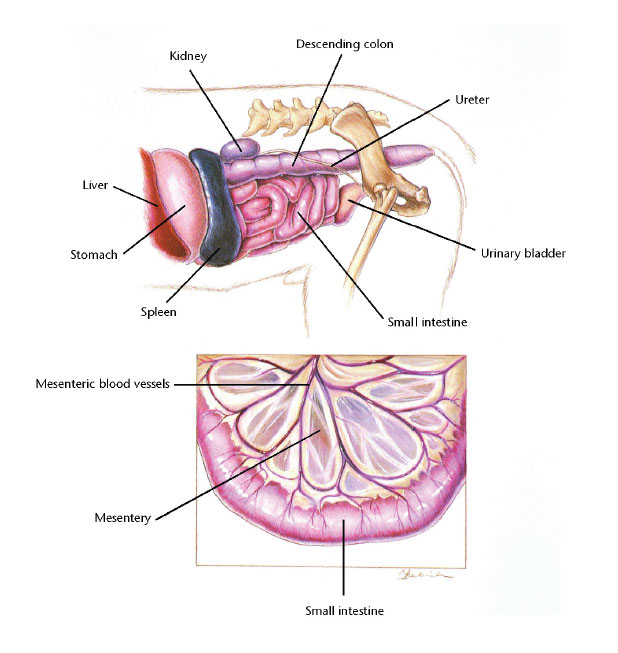
The small intestine connects the stomach to the large intestine. It can be broken into three sections - the duodenum, jejunum and ileum. It is where food absorption continues to take place after it has left the stomach.
Pancreas
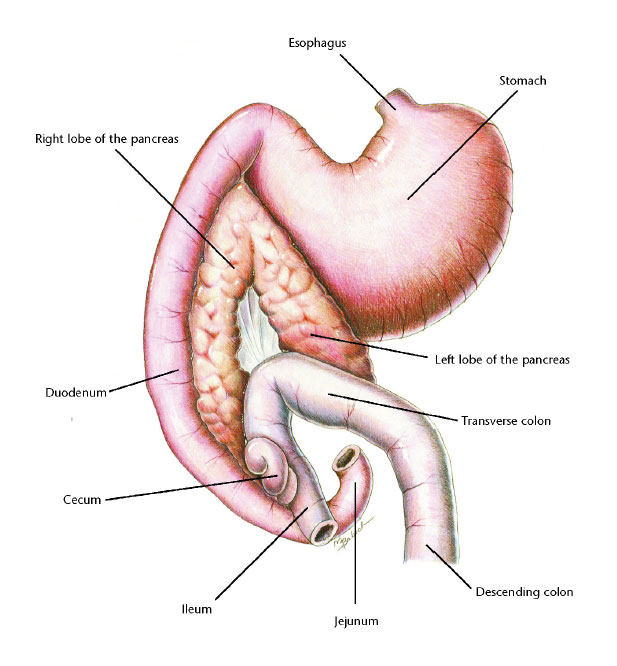
The pancreas is a gland located near the stomach. It produces a number of important hormones that aid in digestion and regulates blood sugar.
Liver
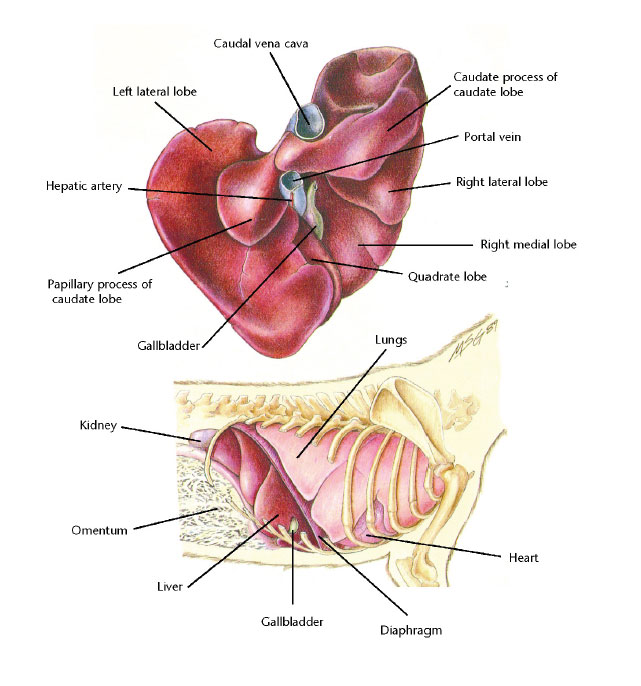
The liver is responsible for removing toxins that come from the digestive tract.
Get access to more anatomical diagrams on the digestive system.
- Hemorrhagic Gastritis with Ulcers
- Gastric Dilatation with Volvulus
- Intestinal Foreign Bodies
- Parvoviral Enteritis
- Intussusception
- Chronic Colitis
- Constipation/Colonic Impaction
- Acute Pancreatitis
- Exocrine Pancreatic Insufficiency
- End-Stage Liver Disease
- Hepatic Neoplasia
Simply register online and once approved, gain access within a few minutes.
JOIN NOWMusculoskeletal system
The musculoskeletal system is responsible for form, support, stability and movement. It is made up of skeletal bones, muscles, cartilage, tendons, ligaments, joints and connective tissue.
The cat has 230 bones, as opposed to 206 within the human body.
Skeleton
The skeleton consists of 5 major areas:
- Spine - cervical, thoracic, lumbar, sacral, caudal regions
- Skull
- Ribs
- Forelimbs
- Hindlimbs
When cats experience a musculosketal injury, they are less likely to walk and prefer to hide in a corner or under a bed. Noting the cat's behaviours from a distance can help give the veterinarian a good idea of what may be going on as cat's are very reluctant participants when it comes to a musculoskeletal examination. Common orthopaedic conditions in cats include forelimb fractures and femoral (large hindlimb bone) fractures. Hip dislocation and cranial cruciate ligament rupture are also common in cats that experience a traumatic event.
Joints
Joints are formed between the union of two or more bones. They connect to the bone with connective tissue e.g. ligaments and tendons. Ligaments attach bone to bone. Tendons attach bone to muscle.
There are two types of joints:
- Ball and socket e.g. shoulder and hip
- Hinge e.g. wrist, stifle, hock
Common joints include the:
- Elbow
- Shoulder
- Hip
- Stifle (knee)
Shoulder
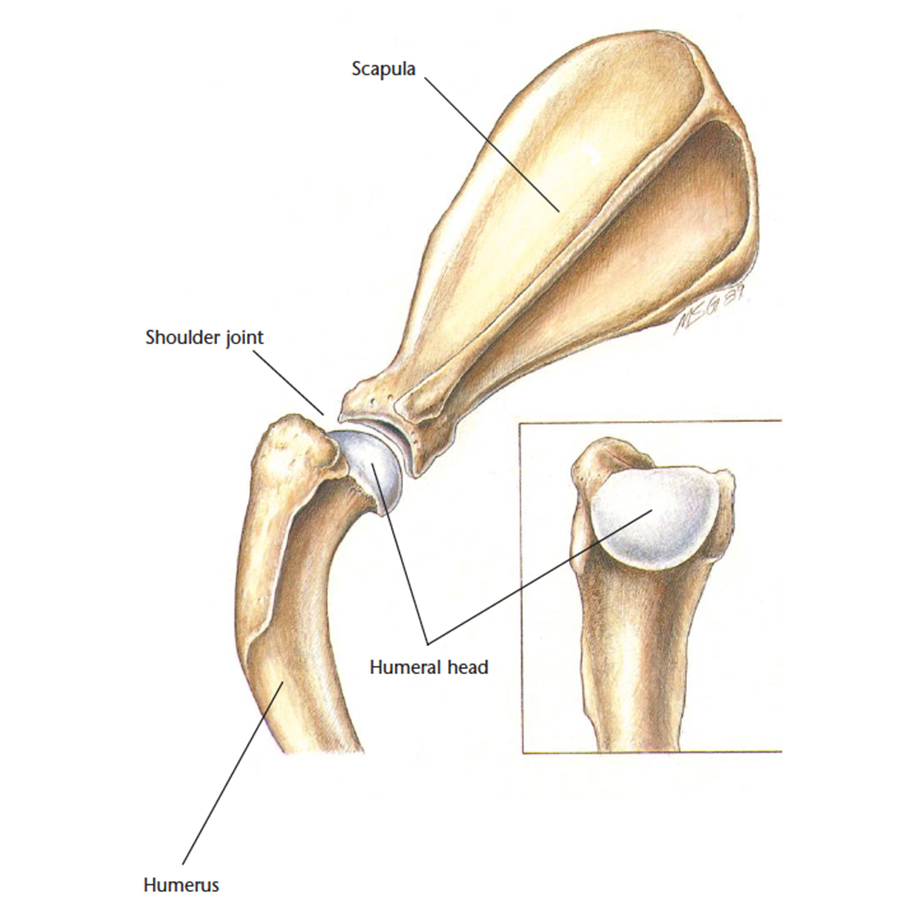
The shoulder joint is made up of the scapula (shoulder blade) and humerus (large arm bone).
Pelvis
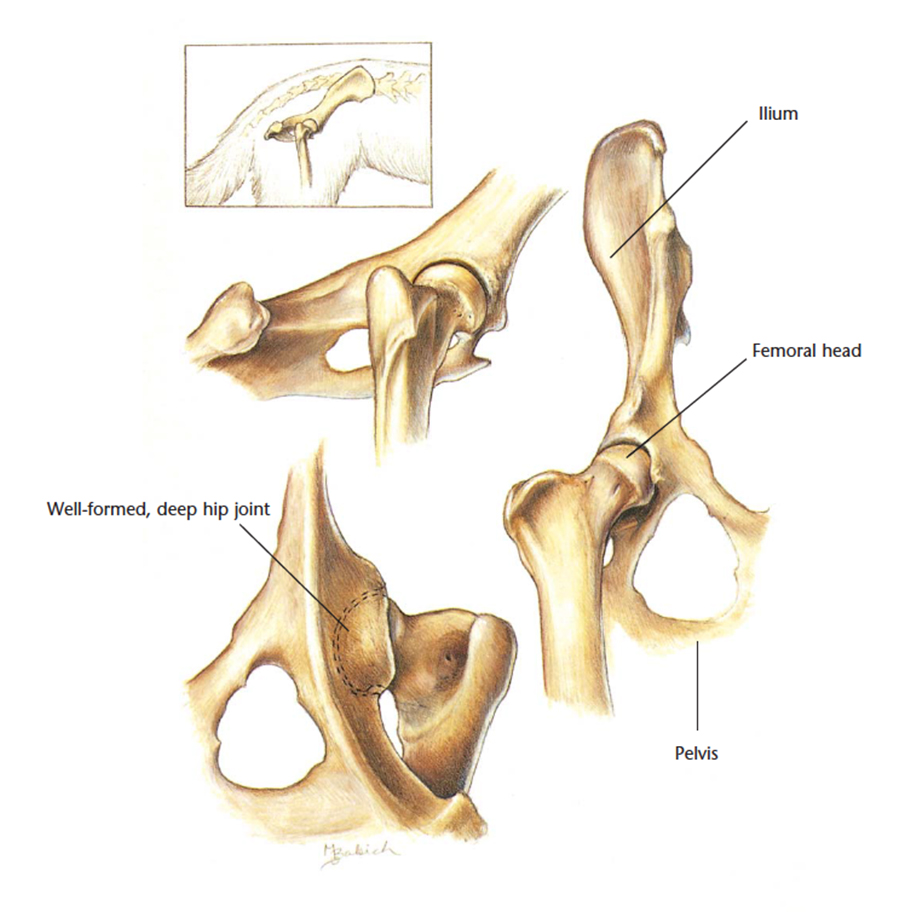
The pelvis is where the femoral (large leg bone) head fits into the hip joint.
Stifle and patella
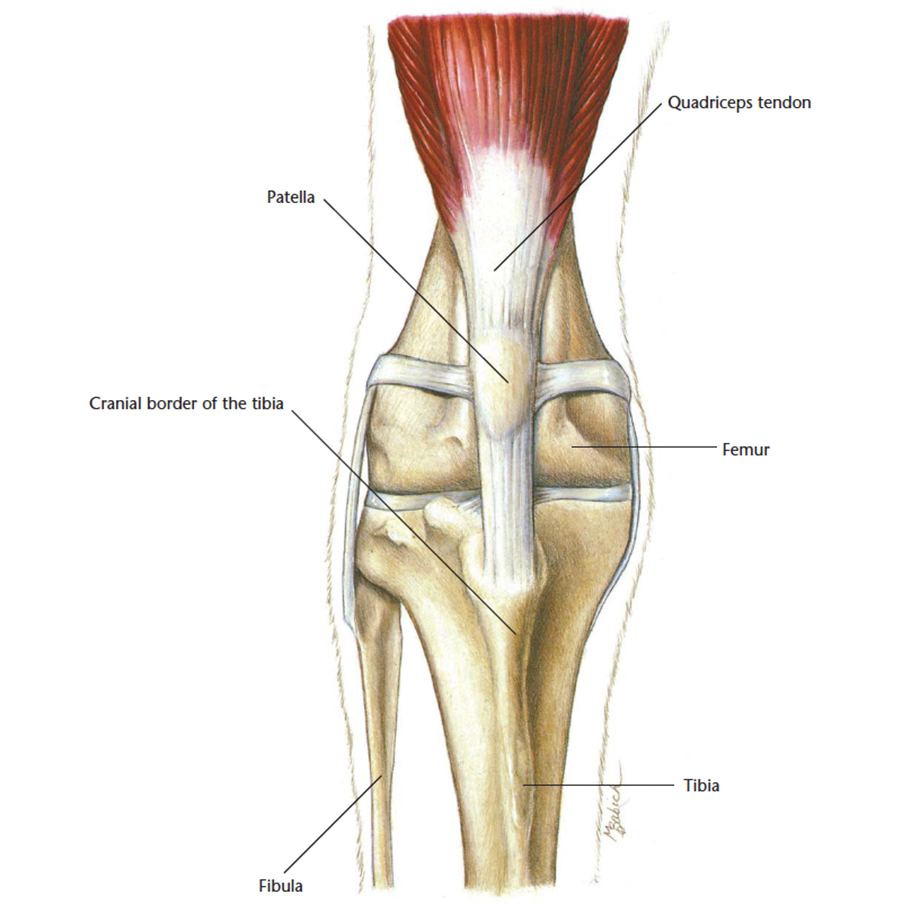
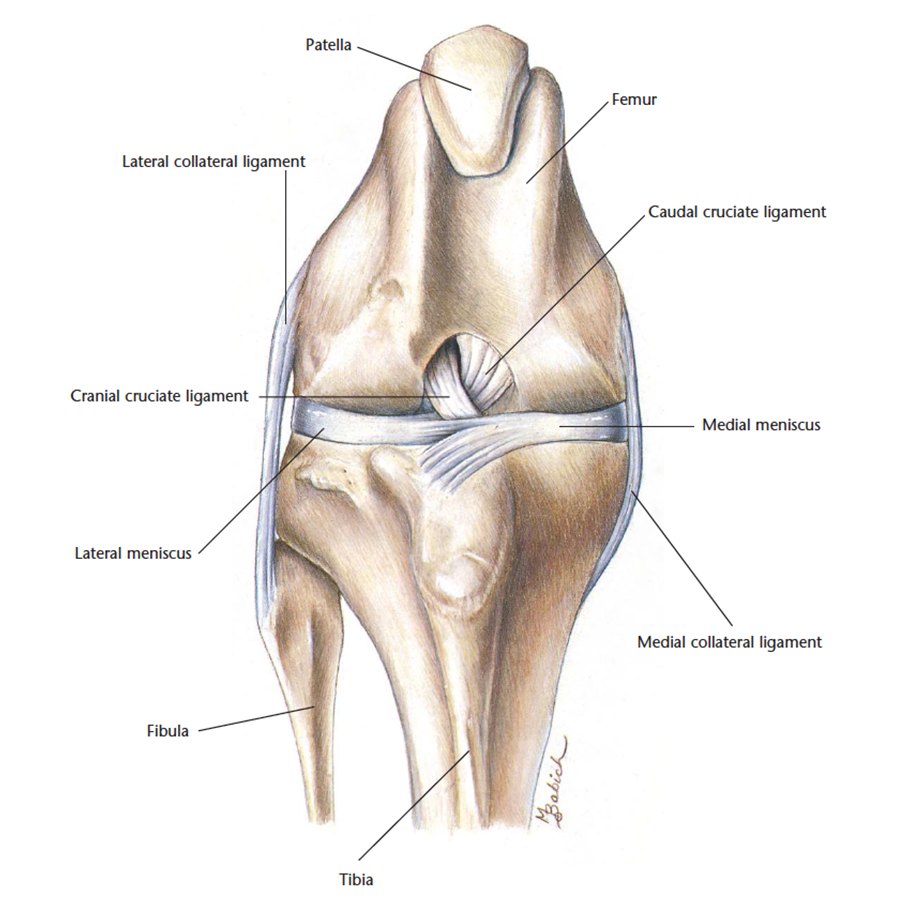
The stifle is the knee and the patella is the knee cap. They are both positioned in the hindlimbs of the cat.
Get access to more anatomical diagrams on the musculoskeletal system.
- Intervertebral Disk Disease
- Osteochondritis Dissecans
- Ununited Anconeal Process/Panosteitis
- Hip Dysplasia
- Femoral Fracture
- Ruptured Cranial Cruciate Ligament
- Patellar Luxation
Simply register online and once approved, gain access within a few minutes.
JOIN NOWRespiratory system
The respiratory system is responsible for bringing oxygen into the body and removing wastes in the form of carbon dioxide. Pets cannot regulate their heat through their skin in the form of sweat - the respiratory system is responsible for regulating the body temperature for example panting when the pet is hot.
View the VetCheck Sleeping Respiratory Rate handout and videoThe respiratory system includes the:
- Nose
- Pharynx
- Larynx
- Trachea
- Bronchi (smaller airways)
- Lungs
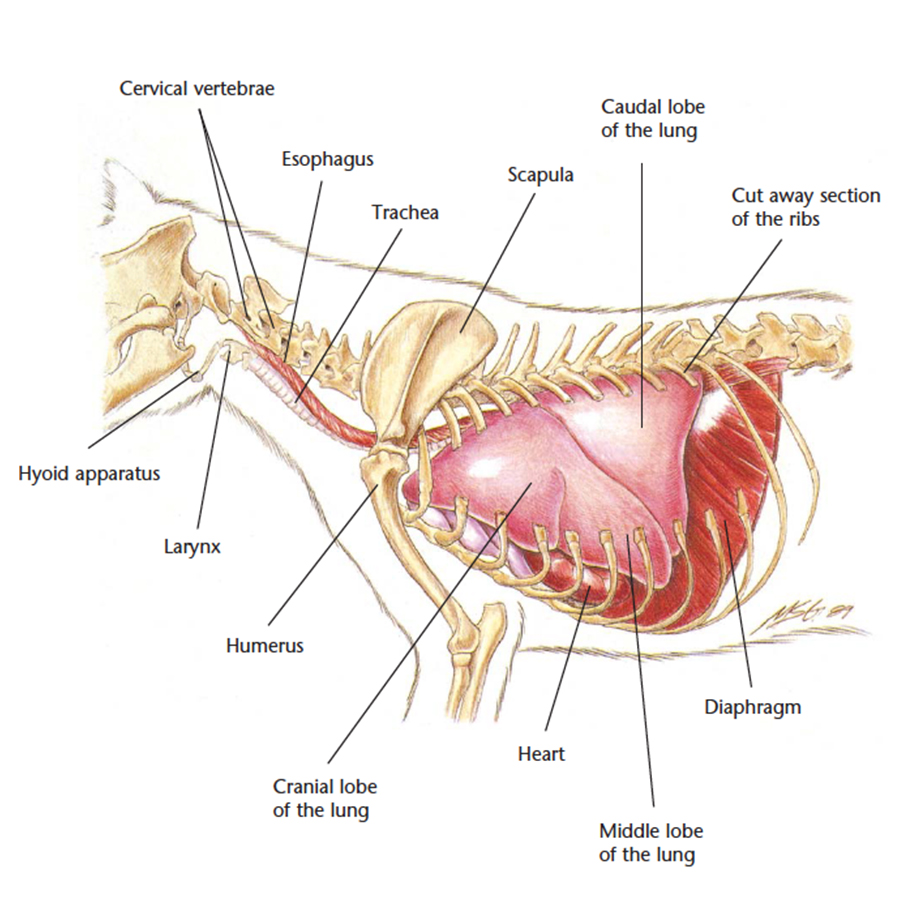
Get access to more anatomical diagrams on the respiratory system.
- Tonsillitis
- Collapsing Trachea
- Pulmonary Edema
JOIN NOW
Urogenital system
The urogenital system refers to the urinary system that includes the kidneys, ureter, urethra and bladder in the excretion of liquid wastes and the reproductive system that includes the female uterus, ovaries, fallopian tubes and vagina and the male testes, epididymis, vas deferens and penis.
Lower urinary tract
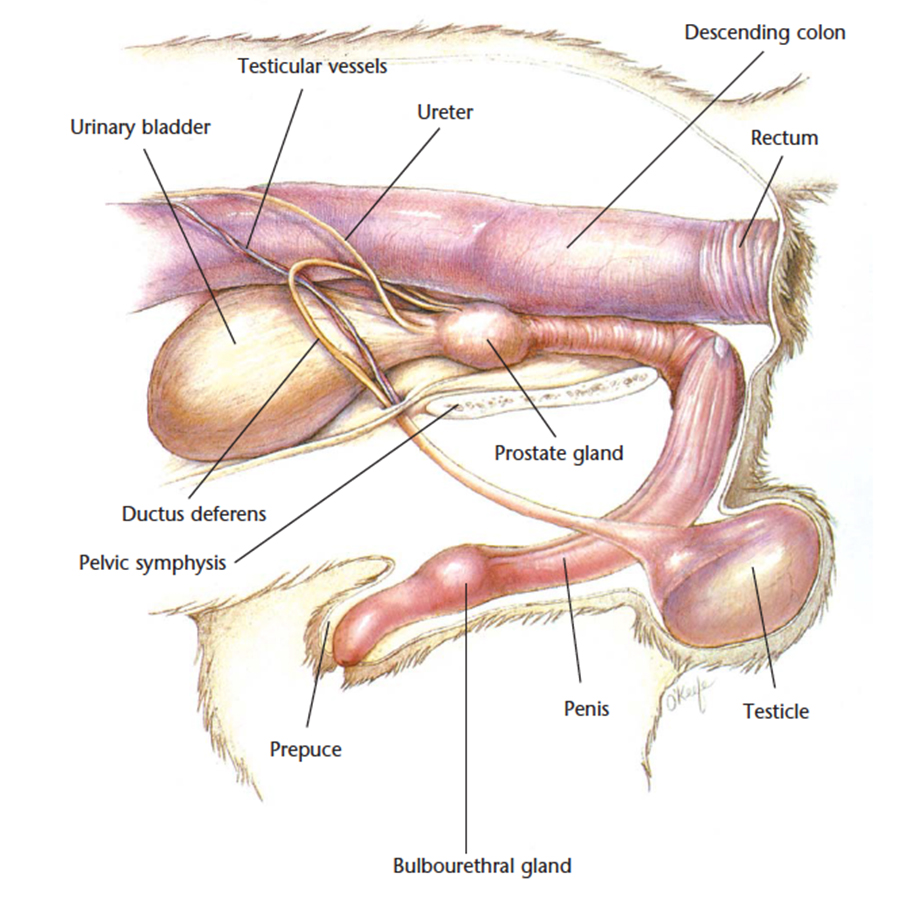
Problems of the lower urinary tract in cats is fairly common. It is estimate that over 50% of cats that suffer from feline lower urinary tract disease, have cystitis (bladder inflammation).
To help prevent this condition:
- Feed smaller amounts of food over 2-3 meals a day
- Feed canned food
- Find a diet with Omega 3 fatty acids to help reduce bladder inflammation
- Provide fresh water in multiple bowls around the house
- Have at least 1.5 litter trays per cat per household
- Reduce stress
Female genitalia

A spey or ovariohysterectomy involves the removal of both ovaries and the uterus. Without desexing, your pet will proceed to puberty and leave bloodstains around the house during each heat cycle.
Benefits of desexing:
- Prevention of unwanted litters
- Health benefits for females such as womb infections (pyometra), breast cancer
- Health benefits for males such as reduced prostate disease, testicular cancer, perianal tumours
- Behavioural benefits such as reduced spraying, marking, fighting if castration occurs before 6 months of age or before the onset of these behaviours
- Prevention of hormonal changes that can interfere with the medical management of pets with diabetes or epilepsy
Desexing is usually recommended before puberty between the age of 4 and 9 months but can occur at any age. Six months is an ideal age as the puppy vaccination series is usually completed. Males undergo a castration which is the removal of both testicles from beneath the skin. Females undergo a spey or ovariohysterectomy which requires abdominal surgery to remove the uterus and ovaries.
Male genitalia
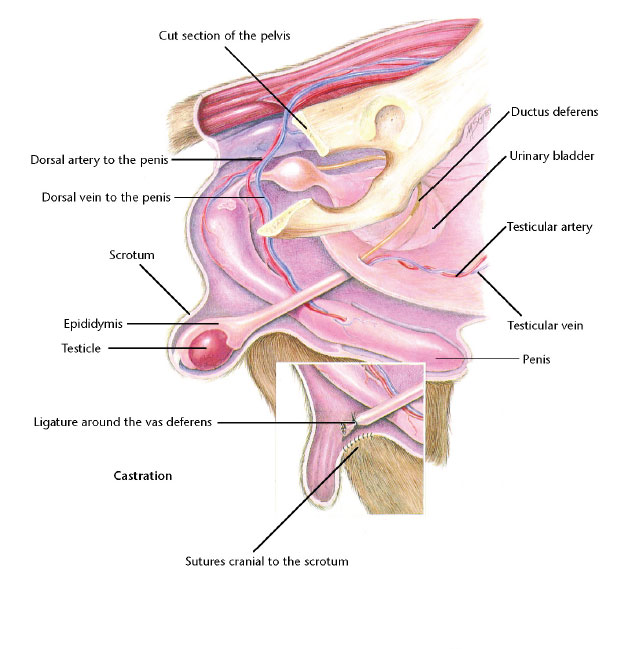
A castration involves the removal of the testicles from within the scrotal sac.
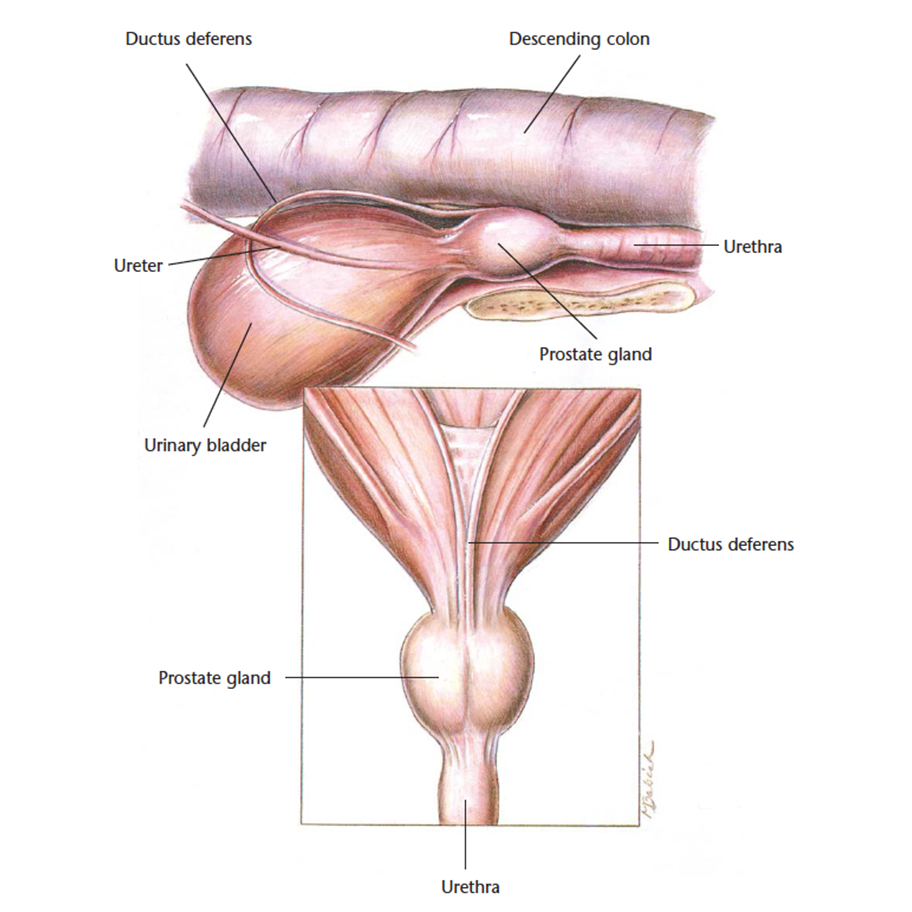
Get access to more anatomical diagrams on the urogenital system.
- Chronic Renal Disease
- Acute Renal Failure
- Bladder Stones
- Urethral Obstruction
- Feline Lower Urinary Tract Disease
- Benign Prostatic Hyperplasia
- Ovariohysterectomy
- Pyometra
- Castration
- Testicular Tumors
Simply register online and once approved, gain access within a few minutes.
JOIN NOWNervous system
The nervous system is responsible for the transmission of messages to and from the brain and spinal cord. The spinal column is protected by the boney spinal vertebrae.
The nervous system includes the:
- Brain
- Spinal cord
- Nerves
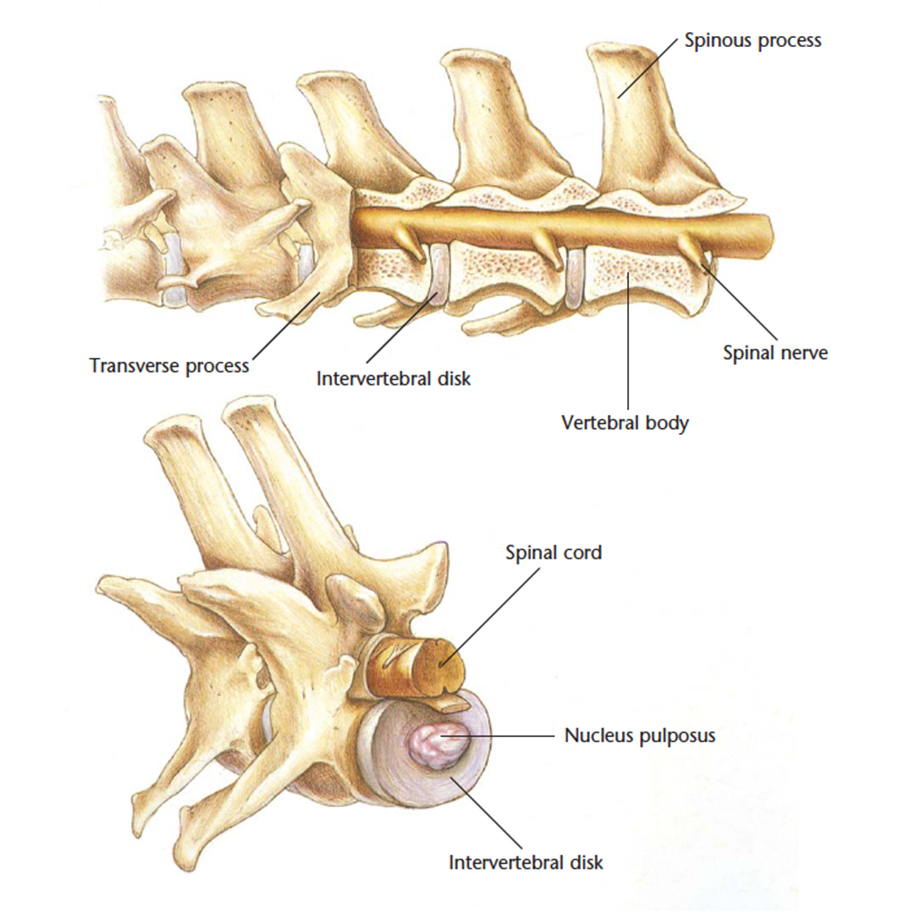
The Cat Eye
The eye is responsible for collecting light from the environment and converting this into an image in a three dimensional, moving image. Although the cat's eye contains functioning red, green and blue photoreceptors, studies suggest that their color vision is poor.
The eye is made up of the:
- Cornea
- Iris
- Ciliary Body
- Vitreous Body
- Retina
- Lens
- Anterior Chamber
- Optic disk
- Optic Nerve
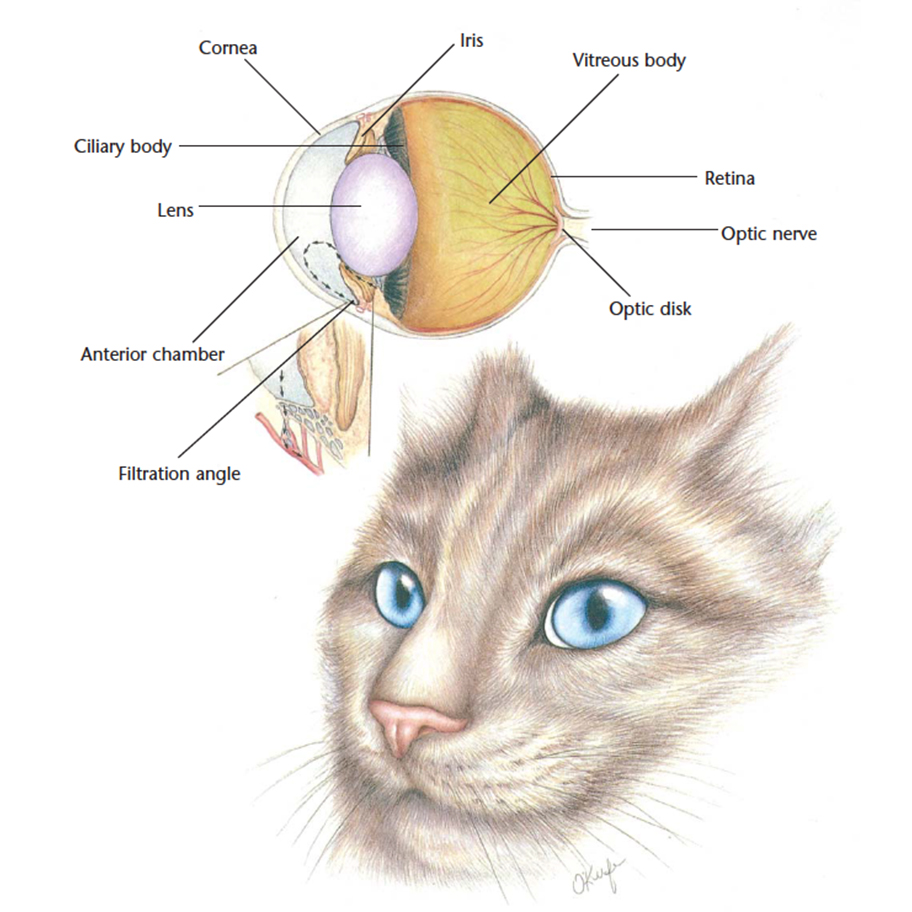
The cat's eye is uniquely different to other mammals. The cat's cornea and pupil are larger, which allows them to let more light in to increase visibility at night. The shape of a cat's pupil is a vertical slit when closed and round when open. Their cornea is less prone to inflammatory disease, making early detection of disease more challenging. Eye conditions in the cat also arise secondary to other disease such as Feline Leukemia Virus, Feline Infectious Peritonitis, Feline Infectious Virus, Toxoplasma, Cryptococcus, Coccidia, Lymphosarcoma and Multiple Myeloma.
Other interesting facts about the cat's eye is that the third eyelid is hidden with the edge barely noticeable. Therefore, visibility is often sign of a problem and can occur with a number of conditions. The cat also does not blink as frequently as other mammals. Their tears are more stable and effective.
Common eye condition terminology
Here are some common eye condition terms and their meanings:
| Conjunctivitis | Inflammation of the pink tissue inside the eyelids. Usually occur secondary to the flu in cats. |
| Uveitis | Inflammation of the middle layer of the eyeball. Represented by eye redness, pain and poor vision. |
| Corneal ulcer | Painful hole in the cornea (the clear membrane on the front of the eye). |
| Keratitis | Inflammation of the cornea. |
| Glaucoma | Increased pressure within the eyeball that can lead to sudden blindness. This is an emergency situation. |
| Lens luxation | Movement of the eye lens out of normal position. |
| Cherry eye | Permanent exposure of the third eyelid. |
| Dry eye | Chronic lack of sufficient eye lubrication that results in irritation of the eye. |
| Retinal detachment | Where the retina comes away from the back wall of the eye. This is an emergency situation. |
| Entropion | The rolling in of the eyelids where the eyelashes constantly rub on the cornea, causing irritation and ulceration. |
| Distichia | Eyelashes that grow from an unusual spot and causes irritation and ulceration. |
| Retinal Dysplasia | Abnormal retinal development that can lead to retinal detachment. |
Common eye tests that can be performed at the vets:
| Schirmer tear test | Used to meature the tear production. Normal tear production is 10-15mm in one minute. |
| Swab | Sample collection to investigate foreign cells, bacteria or viruses. |
| Fluorescein staining | To check for ulcers that will absorb the stain and fluoresce. It can also be use to check the functioning of the tear duct, where the stain will appear from the nostrils within 5-15minutes if healthy. |
| Tonometry | Tests the pressure within the eye. |
| Gonioscopy | Tests the drainage angle of the eye. |
| Imaging techniques | The use of radiographs, ultrasound or MRI to investigate diseases of the eye or surrounding tissue. |
| DNA swab | The collection of cheek cells or blood to investigate genetic disorders via specific genetic markers. |
Get access to more anatomical diagrams on the eye.
- Normal eye
- Nusclear sclerosis
- Cataracts
- Glaucoma
- Corneal ulceration
Simply register online and once approved, gain access within a few minutes.
JOIN NOWReferences
Garcia-Retamero, R., & Cokely, E.T. (2013). Communicating health risks with visual aids. Current Directions in Psychological Science, 22 (5), 392-399.
These illustrations are available with permission by the copyright owner, Hill's Pet Nutrition, from the Atlas of Veterinary Clinical Anatomy. This illustration should not be downloaded, printed or copied except for non-commercial use.
© Hill's Pet Nutrition Pty Ltd.
Interested in a product tour?
In this demo, we will show you how VetCheck can make your life easier and grow your practice through better client engagement.
Book a 15-minute Demo